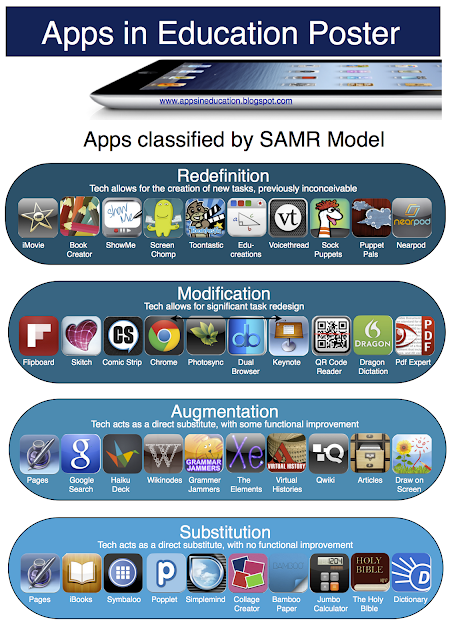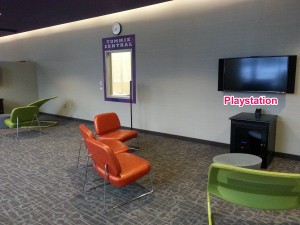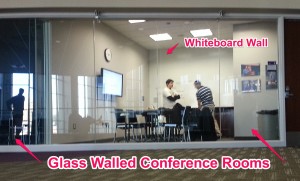Car Ride
Before I start I want to thank Casey Wagner for her help organizing the trip, Craig Overboe for organizing the van, and Jim Pesta for driving us all down to GusDay. We headed out at 7:00 AM and had some light conversation on the way down. It was good to hear a little about what else was happening outside of the Miller Center from Chris Fandel, Jim Pesta, and Aaron Gordon. We talked a little about rooms on campus that might be good candidates for collaboration spaces. Mentioned were a lab in the 2nd floor of the Education building, B31 in the Miller Center, and spaces in the Miller Center library.
Arrival: Anderson Student Center
Once we arrived at the Anderson Student Center at the University of St. Thomas we could see a fun recreation area through the windows. While the outside of the building was an old-school brick, inside was a much more open and modern layout. The building was awesome, with lots of windows, a huge atrium, windows conference rooms, and oodles of digital signage.
Pictures of main atrium:



Another thing I noticed right away was a ton of glass walled conference and collaboration rooms. I noticed a few students collaborating on a floor to ceiling whiteboard and took a quick picture.
Another thing we noticed was that they did a great job of featuring outstanding students on their digital signage:


Keynote: Motivation & Team Performance, Dr. John Tauer
The keynote speaker was John Tauer, who is the head men’s basketball coach and also a professor in the department of psychology. John did a really good job with the keynote address. Two items from his talk stuck out to me. The first was the “Parable of Ausubel” – the message was that sometimes reframing a situation can cause a paradigm shift and turn a negative into a positive. I was left wondering what projects I could possibly apply the idea to. The second was his statement that one trait that the most successful people have is resilience. It was a good reminder of the importance of not giving up.
Session 1: Infrastructure Round-Table
There was some discussion about fiber channel vs. iSCSI vs. FCoE. A little talk about backup tools and strategy. But the biggest note I took during this session was that there was a consensus among the schools that they are not needing to add more storage for students. One school will actually stop provisioning any personal storage for students this year.
Session 2: iPads in Higher Ed: Success Stories in the Classroom
Next up was a session on iPads in the classroom. Ben Phillip from Hamline was the first speaker. Ben works in Hamline’s Center for Teaching and Learning department. As we seek to develop a strategy for our own Center for Excellence in Teaching and Learning, I think it makes sense to reach out to Hamline and others to get feedback on what is working in their organizations. Ben talked about how they’ve setup an iPad user group and how that group works as well as their iPad cart.
Matthew Hammen from Luther College in Iowa was up next. Mathew presented from his iPad connecting wirelessly to the computer. He talked about their success using AirServer in their classrooms. He also talked about his realization of the iPad as a game changing device that enables mobility in learning. Matthew also talked about their iPad checkout program.
Both Matthew and Ben talked about evaluating apps for learning by leveraging the SAMR model developed by Dr. Ruben R. Puentedura. The SAMR model categorizes apps into four buckets: substitution, augmentation, modification, and redefinition. They gave the example of writing a paper.
-
Substitution: Typewriter
- Substitute pen for typewriter.
-
Augmentation: Word Document
- Augment paper with a portable document with metadata, etc.
-
Modification: Google Doc
- Create a paper by allowing multiple users to contribute at the same time.
-
Redefinition: Video
- Create an entirely new product that is conveyed in a different medium.
 They also shared a poster that Greg Swanson had put online at the Apps in Education site that gave examples of how some apps could be classified using the SAMR model. See image to the right.
They also shared a poster that Greg Swanson had put online at the Apps in Education site that gave examples of how some apps could be classified using the SAMR model. See image to the right.
I had four key takeaways from this session. The first was that we should explore implementing AirServer in our eClassrooms. The second was that the SAMR model could be very valuable in evaluating technology and apps that we deploy. Third was that the tablet form factor can really redefine the learning experience. And lastly, we need to reach out to other institutions to collaborate on best practices for excellence in teaching and learning.
Here is a great video off of Dr. Ruben Puentedura’s blog describing a bit about the SAMR model and more.
Lunch: The View
Lunch was great. We had some light conversation. The “big idea” discussed was redesigning Miller Center B31 into a collaborative learning space. Removing the traditional desktops and replacing them with a mobile device cart with devices like the Apple MacBook Pro, Microsoft Surface Pro, and/or Lenovo Helix. Much like the iPad Cart described in Session 2. Then leveraging AirServer for the tablets to display on the instructor screen at the front of the room. We could possibly leverage a device checkout system like used at Drexel – for use in B31 or elsewhere on campus.
Session 3: Optimizing Enterprise Desktop Deployment with the Microsoft Deployment Toolkit
There was not too much to report back from this session, other than to say the University of St. Thomas and others are moving toward Microsoft deployment tools like the Microsoft Deployment Toolkit and System Center Configuration Manager and away from 3rd party tools like Symantec/Altiris much like the path SCSU is on. This is another opportunity for future collaboration.
Session 4: Identity and Access Management in Higher Ed
This was the session that hit home for me the hardest. There were several schools that had been using the Sun Identity Management product recently purchased by Oracle. There was consensus that Oracle had done a poor job with the transition offering little support for the Sun product and forcing an expensive commitment to move forward with the Oracle offering. Everyone had decided to look for an alternative. This is exactly the situation we are in at MNSCU. For most folks it came down to Quest/Dell, NetIQ, and Microsoft. While folks really liked the Quest offering, price made it a non-starter leaving Microsoft and NetIQ as the reasonable options. It seemed that folks with a more Microsoft centric backend selected Microsoft and folks with a more Linux-based backend NetIQ was the selection.
There was a good conversation about identity structure within Active Directory and how to manage the provisioned accounts. Additionally, the handling of a complex and large backend system (UST has almost a million rows in their ERP system), guest accounts, supplemental/sponsored accounts, passwords management, and more were discussed.
Trip Back to SCSU
The trip back was filled with conversation about file storage and user profiles. As the backend administrator for these services I was all-in on this conversation (I probably would have been better served practicing my listening skills…). We talked about SharePoint as an alternative to traditional file services. We talked about the potential move to drop roaming profiles and personal file storage for students offering only a cloud based file storage solution. I spoke about my interest in deploying Box and leveraging Evernote as cloud-based collaboration tools. It was great to hear creative ideas from Craig Overboe and hear about upcoming strategies from Casey Gordon.
If you are interested in checking out my raw notes, here is a link to my Evernote shared notebook:
https://www.evernote.com/pub/scsuitguy/gusday2013





